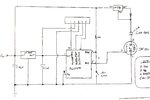mnvelocitypilot
Junior Member level 1
Hi Team - I could sure use some input on this...
I'm working on a replacement strobe system for my experimental Velocity aircraft... I've been getting stuck on using an IRF1501 N channel power Mosfet to switch on and off the approximately 2 amps I'm using to drive 5 10W Cree LEDs.... But I can only get about 0.9A through the Mosfet. Essentially, it's almost like the Mosfet is in an active range instead of saturated.
... Here's the setup:
The current limited supply connected to the LED anode is around 16 volts
The LED cathode is connected to the Mosfet Drain
The Mosfet Source is grounded.... and,
The Mosfet Gate is driven by a PIC controller.
The measured voltages are as follows:
Vds = 3.2V (wow.... with a spec'd Mosfet internal resistance of around 0.4 ohms, and a drain to source current measured at only 0.9A, that seems mighty high... more like an internal resistance of 3.5 ohms...)
Vgs = 4.94V (seems about right)
Vdg = 1.72V (which makes sense... Vdg + Vds = about Vgs)
So... Why in the heck is there such a huge voltage drop across the Mosfet? Why isn't it conducting my full supply current of about 2A? Why, why WHY???
BTW, I'm planning to up the current if I can get this thing going to about 4.8 - 5 Amps... which is why I chose not to use a Mosfet and not a power transistor...
Any thoughts would be REALLY appreciated... I'm stuck!
Thanks.
I'm working on a replacement strobe system for my experimental Velocity aircraft... I've been getting stuck on using an IRF1501 N channel power Mosfet to switch on and off the approximately 2 amps I'm using to drive 5 10W Cree LEDs.... But I can only get about 0.9A through the Mosfet. Essentially, it's almost like the Mosfet is in an active range instead of saturated.
... Here's the setup:
The current limited supply connected to the LED anode is around 16 volts
The LED cathode is connected to the Mosfet Drain
The Mosfet Source is grounded.... and,
The Mosfet Gate is driven by a PIC controller.
The measured voltages are as follows:
Vds = 3.2V (wow.... with a spec'd Mosfet internal resistance of around 0.4 ohms, and a drain to source current measured at only 0.9A, that seems mighty high... more like an internal resistance of 3.5 ohms...)
Vgs = 4.94V (seems about right)
Vdg = 1.72V (which makes sense... Vdg + Vds = about Vgs)
So... Why in the heck is there such a huge voltage drop across the Mosfet? Why isn't it conducting my full supply current of about 2A? Why, why WHY???
BTW, I'm planning to up the current if I can get this thing going to about 4.8 - 5 Amps... which is why I chose not to use a Mosfet and not a power transistor...
Any thoughts would be REALLY appreciated... I'm stuck!
Thanks.

